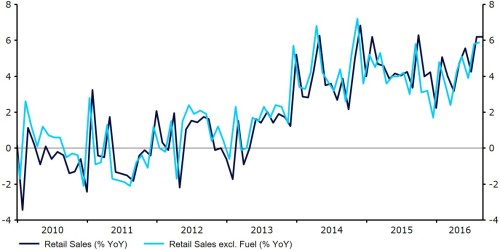Sterling falls after Bank of England hints at a further interest rate cut
- Go back to blog home
- Latest
The Pound slipped against its major peers on Thursday after the Bank of England left its monetary policy unchanged and hinted that it remained likely to cut interest rates to just above zero later in the year.
The committee acknowledged the bounce back in economic activity since the Brexit vote and subsequently revised upwards its third quarter growth forecast to 0.3% from 0.1%. However, the minutes of the meeting left the door open to further stimulus later in the year with a ‘majority’ of members expected to pledge support to a further cut in the benchmark rate at forthcoming meetings.
The next meeting, in the first week of November, therefore provides the first realistic opportunity for a second rate cut, with some economists already eying up a 15 basis point reduction in the main rate. We await the next PMI indicators in the first week of October for a better indication as to the central bank’s next move.
Retail sales in the US yesterday were overwhelmingly disappointing, briefly sending the Greenback to a near one week low against the Euro. The historically volatile measure showed that sales fell by a greater-than-expected 0.3% in August, with July’s number also revised downwards. We think this provides further evidence that the Federal Reserve is highly unlikely to hike interest rates at its much anticipated monetary policy meeting next week.
US inflation data at 13:30 UK time will be the main event in the currency markets today.
Major currencies in detail:
GBP
Sterling fell 0.15% against the Dollar on Thursday following the BoE meeting.
Yesterday’s meeting marked the last scheduled monthly meeting of the Bank of England, with policymakers in the UK now set to follow the lead of the Fed and ECB by convening every six weeks.
We think the BoE could wait until after Chancellor Philip Hammond’s Autumn Statement in November before cutting rates further, in order to observe the effect of any potential fiscal stimulus on the UK economy.
Earlier in the day, retail sales provided a pleasant upward surprise in August, continuing to suggest UK consumers are ignoring the uncertainty created by the Brexit vote. Sales rose by a better-than-expected 6.2% in the year to August (Figure 1), with July’s number also revised upwards by 0.4%. Excluding fuel, sales increased by 5.9% in the year, much higher than the 4.8% forecast.
Figure 1: UK Retail Sales (2010 – 2016)
With no economic data out in the UK today, Sterling will likely be driven by events elsewhere.
EUR
Weak US retail sales sent the Euro 0.15% higher against the US Dollar yesterday.
Inflation data remained unrevised in the Eurozone yesterday, as expected. Consumer prices grew just 0.2% in the year to August, with the European Central Bank continuing to look a long way off reaching its ‘close to but just below 2%’ inflation target. Core inflation, which strips out volatile energy prices, came in at just 0.8% last month, having now failed to break above 1% in every month but one for the past two years.
Data yesterday also showed that the trade surplus in the Eurozone fell to €25.3B in August.
Today looks set to be a quiet day in the Eurozone, with no major economic releases in the pipeline.
USD
The US Dollar index dipped 0.1% following Thursday’s retail sales miss.
Economic data out of the US was poor across the board yesterday, making a Fed rate hike next week increasingly unlikely. Industrial production fell in August, declining 0.4% for the month, its largest monthly fall since March. Capacity utilisation, the Producer Price Index and the New York Empire State Manufacturing Index all also came in below expectations.
US inflation data for August this morning is expected to show headline consumer price growth accelerated to 1% last month from the 0.8% recorded in July. Investors will already have one eye on next Wednesday’s Federal Reserve meeting.
Receive these market updates via email


